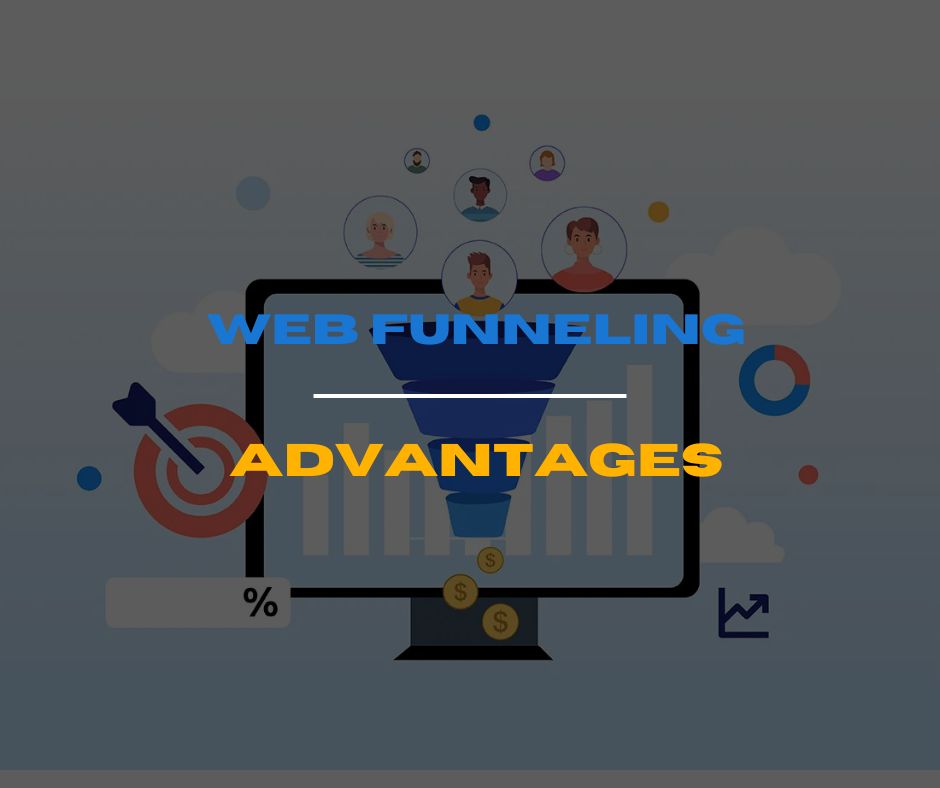From Browsers to Buyers: The Magic of Web Funneling
1. Introduction
2. Defining Web Funneling
3. The Role of Web Funnels in Digital Marketing
4. Advantages of Web Funneling for Businesses
- Enhanced Lead Generation
- Improved Conversion Rates
- Streamlined Customer Journey
- Increased Customer Engagement
- Greater Return on Investment (ROI)
5. Benefits of Data-Driven Decision Making
6. Personalization and Customer Experience
7. Automation and Efficiency
8. Enhancing Brand Visibility and Authority
9. Case Studies and Success Stories
10. Future Trends in Web Funneling
11. Conclusion
—–
1. Introduction
In an era defined by digital transformation, web funneling has emerged as an indispensable strategy for modern businesses. By systematically guiding prospects from initial awareness to final conversion, web funnels empower companies to optimize their marketing efforts, streamline customer interactions, and ultimately, bolster revenue. This article explores the multifaceted advantages of web funneling, providing an in-depth analysis of its strategic significance in today’s competitive marketplace.
1.1 Overview of Web Funneling
Web funneling is a structured process that transforms casual website visitors into engaged customers. It involves a series of targeted steps, each designed to nurture prospects along their buyer journey. This strategic approach not only increases conversion rates but also ensures that every interaction is purposefully aligned with overarching business objectives.
1.2 The Relevance of Web Funneling in Modern Business
The contemporary business landscape is characterized by intense competition and rapidly shifting consumer behavior. In this milieu, web funneling provides a tactical edge by enabling companies to deliver personalized experiences, thereby increasing both customer satisfaction and loyalty. Its relevance is underscored by the fact that it integrates seamlessly with digital marketing strategies, making it an essential tool for businesses aiming to thrive in the digital age.
2. Defining Web Funneling
2.1 What is Web Funneling?
Web funneling refers to the deliberate design and implementation of a conversion pathway that channels potential customers through a series of optimized stages. This process typically begins with attracting a broad audience and culminates in the conversion of leads into loyal customers. The funnel’s architecture is built on principles of persuasion and data-driven insights, ensuring that each stage effectively addresses consumer needs and anticipates their queries.
2.2 Key Components of a Web Funnel
A robust web funnel comprises several critical components: lead capture forms, landing pages, email marketing sequences, and analytics tools. These elements work synergistically to track user behavior, segment audiences, and deliver targeted content that resonates with each prospect. The integration of these components is what distinguishes a high-performing web funnel from a generic marketing approach.
3. The Role of Web Funnels in Digital Marketing
3.1 Integrating Web Funnels with Digital Strategies
Web funnels are a cornerstone of digital marketing, seamlessly merging with tactics such as search engine optimization (SEO), content marketing, and pay-per-click (PPC) advertising. By integrating funnel strategies, businesses can ensure that every digital touchpoint is optimized for conversion. This holistic approach not only amplifies brand visibility but also enhances the overall customer journey.
3.2 Aligning Sales and Marketing Goals
A well-crafted web funnel harmonizes the efforts of sales and marketing teams. Through consistent messaging and strategic lead nurturing, these teams can collaboratively drive higher conversion rates. This alignment ensures that marketing campaigns generate high-quality leads, which the sales team can then convert into profitable customers.
4. Advantages of Web Funneling for Businesses
4.1 Enhanced Lead Generation
One of the most significant advantages of web funneling is its capacity to generate high-quality leads. By attracting targeted traffic and filtering out uninterested visitors, a well-designed funnel ensures that only the most promising prospects advance through the stages of the customer journey.
4.2 Improved Conversion Rates
Web funnels are engineered to optimize conversion rates at every stage. Through a combination of persuasive content, compelling calls-to-action (CTAs), and data-backed insights, businesses can effectively guide visitors toward making purchasing decisions. This structured approach minimizes friction in the buying process and maximizes conversion potential.
4.3 Streamlined Customer Journey
The customer journey can often be convoluted, leading to lost opportunities. Web funneling simplifies this process by providing a clear, linear path for prospects. This clarity not only improves the user experience but also ensures that potential customers are consistently engaged from the first touchpoint to the final sale.
4.4 Increased Customer Engagement
Engagement is the lifeblood of successful digital marketing. Web funnels facilitate ongoing interactions through targeted content and personalized communication. By keeping prospects engaged, businesses can build stronger relationships and nurture leads over time, ultimately fostering long-term loyalty.
4.5 Greater Return on Investment (ROI)
Investing in a sophisticated web funnel yields measurable returns. By effectively converting leads into customers, businesses can achieve a significantly higher ROI compared to traditional marketing approaches. The cost-effectiveness of web funneling lies in its precision—allocating resources where they yield the greatest impact.
5. Benefits of Data-Driven Decision Making
5.1 Analytics and Performance Tracking
Modern web funnels are equipped with robust analytics tools that provide real-time insights into user behavior and campaign performance. This data-driven approach enables businesses to continually refine their strategies, ensuring that every decision is informed by actionable metrics.
5.2 A/B Testing and Funnel Optimization
A/B testing is an integral component of web funneling. By experimenting with different elements—such as landing page designs, CTAs, and content layouts—businesses can determine which variants yield the best results. Continuous optimization based on empirical data is crucial for maintaining an edge in competitive markets.
6. Personalization and Customer Experience
6.1 Tailored Content and Messaging
Personalization is key to capturing and retaining customer interest. Through web funneling, businesses can deliver bespoke content and messaging that aligns with the unique needs and preferences of each prospect. This tailored approach enhances engagement and fosters a deeper connection with the brand.
6.2 Improved User Experience and Satisfaction
A user-centric design is paramount for the success of any web funnel. By streamlining the navigation process and ensuring that every interaction is intuitive, businesses can significantly enhance the overall user experience. Satisfied customers are more likely to complete the desired actions, from signing up for newsletters to making a purchase.
7. Automation and Efficiency
7.1 Workflow Automation in Web Funnels
Automation plays a pivotal role in the efficiency of web funnels. Automated workflows can handle repetitive tasks, such as sending follow-up emails and segmenting leads, thereby freeing up valuable time for strategic planning and creative endeavors. This not only increases operational efficiency but also ensures that no lead is neglected.
7.2 Time and Resource Optimization
Web funneling is designed to optimize both time and resources. By automating routine processes and focusing on high-impact strategies, businesses can achieve more with less. This streamlined approach reduces operational costs while maximizing the potential for revenue generation.
8. Enhancing Brand Visibility and Authority
8.1 Establishing Trust Through Consistency
Consistency in messaging and user experience is crucial for building brand trust. A well-executed web funnel reinforces brand identity at every touchpoint, ensuring that prospects receive a unified and reliable impression of the business. This consistency is vital for establishing long-term authority in the digital space.
8.2 Building Long-Term Customer Relationships
The advantages of web funneling extend beyond immediate conversions; they also lay the foundation for enduring customer relationships. By nurturing leads with valuable content and consistent engagement, businesses can foster loyalty and encourage repeat business over time.
9. Case Studies and Success Stories
9.1 E-commerce Success Through Funnel Optimization
Numerous e-commerce enterprises have reaped the benefits of meticulous funnel optimization. By harnessing the power of web funnels, these businesses have experienced remarkable improvements in conversion rates and customer retention, demonstrating the tangible benefits of a strategic approach.
9.2 Service-Based Businesses Leveraging Web Funnels
Service-oriented companies have also successfully adopted web funneling to streamline their lead generation and conversion processes. From professional services to local enterprises, the adaptability of web funnels has proven invaluable in driving growth and enhancing customer engagement.
10. Future Trends in Web Funneling
10.1 Emerging Technologies in Funnel Marketing
The digital marketing landscape is in a constant state of evolution, with emerging technologies reshaping the way businesses approach web funneling. Innovations such as interactive content, chatbots, and immersive multimedia experiences are set to redefine customer engagement in the near future.
10.2 Predictive Analytics and AI Integration
Artificial intelligence and predictive analytics are revolutionizing web funnel optimization. By leveraging these advanced technologies, businesses can anticipate customer behavior, personalize interactions at scale, and refine their funnel strategies with unprecedented precision.
11. Conclusion
11.1 Recap of Key Advantages
Web funneling offers a myriad of advantages for businesses, including enhanced lead generation, improved conversion rates, and a streamlined customer journey. Its data-driven approach, coupled with the power of personalization and automation, makes it an indispensable tool for modern digital marketing.
11.2 Final Thoughts on the Strategic Value of Web Funneling for Businesses
In a world where digital interactions dictate success, the strategic implementation of web funnels can be the differentiator that propels businesses to new heights. Embracing the advantages of web funneling not only optimizes marketing efforts but also establishes a robust framework for sustained growth and competitive excellence. By integrating cutting-edge technologies and continuously refining their strategies, forward-thinking businesses can unlock the full potential of web funneling, ensuring long-term success in an ever-evolving digital landscape.
—
By adopting and optimizing web funneling strategies, businesses can achieve remarkable improvements in lead generation, conversion efficiency, and overall digital performance. The multifaceted advantages presented in this article underscore why web funneling is a critical component of any robust digital marketing strategy, offering a competitive edge in today’s fast-paced business environment.

